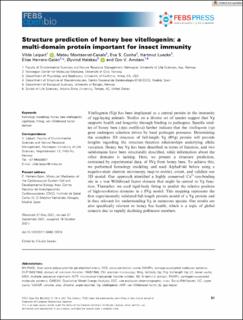| dc.contributor.author | Leipart, Vilde | |
| dc.contributor.author | Montserrat Canals, Mateu | |
| dc.contributor.author | Cunha, Eva S. | |
| dc.contributor.author | Luecke, Hartmut | |
| dc.contributor.author | Herrero-Galán, Elías | |
| dc.contributor.author | Halskau, Øyvind | |
| dc.contributor.author | Amdam, Gro Vang | |
| dc.date.accessioned | 2022-02-14T13:40:14Z | |
| dc.date.available | 2022-02-14T13:40:14Z | |
| dc.date.created | 2021-11-15T19:55:29Z | |
| dc.date.issued | 2022 | |
| dc.identifier.issn | 2211-5463 | |
| dc.identifier.uri | https://hdl.handle.net/11250/2978852 | |
| dc.description.abstract | Vitellogenin (Vg) has been implicated as a central protein in the immunity of egg-laying animals. Studies on a diverse set of species suggest that Vg supports health and longevity through binding to pathogens. Specific studies of honey bees (Apis mellifera) further indicate that the vitellogenin (vg) gene undergoes selection driven by local pathogen pressures. Determining the complete 3D structure of full-length Vg (flVg) protein will provide insights regarding the structure–function relationships underlying allelic variation. Honey bee Vg has been described in terms of function, and two subdomains have been structurally described, while information about the other domains is lacking. Here, we present a structure prediction, restrained by experimental data, of flVg from honey bees. To achieve this, we performed homology modeling and used AlphaFold before using a negative-stain electron microscopy map to restrict, orient, and validate our 3D model. Our approach identified a highly conserved Ca2+-ion-binding site in a von Willebrand factor domain that might be central to Vg function. Thereafter, we used rigid-body fitting to predict the relative position of high-resolution domains in a flVg model. This mapping represents the first experimentally validated full-length protein model of a Vg protein and is thus relevant for understanding Vg in numerous species. Our results are also specifically relevant to honey bee health, which is a topic of global concern due to rapidly declining pollinator numbers. | en_US |
| dc.language.iso | eng | en_US |
| dc.publisher | Wiley | en_US |
| dc.rights | Navngivelse 4.0 Internasjonal | * |
| dc.rights.uri | http://creativecommons.org/licenses/by/4.0/deed.no | * |
| dc.title | Structure prediction of honey bee vitellogenin: a multi-domain protein important for insect immunity | en_US |
| dc.type | Journal article | en_US |
| dc.type | Peer reviewed | en_US |
| dc.description.version | publishedVersion | en_US |
| dc.rights.holder | Copyright 2021 The Authors. | en_US |
| cristin.ispublished | true | |
| cristin.fulltext | original | |
| cristin.qualitycode | 1 | |
| dc.identifier.doi | 10.1002/2211-5463.13316 | |
| dc.identifier.cristin | 1954879 | |
| dc.source.journal | FEBS Open Bio | en_US |
| dc.source.pagenumber | 51-70 | en_US |
| dc.relation.project | Norges forskningsråd: 187615 | en_US |
| dc.identifier.citation | FEBS Open Bio. 2022, 12 (1), 51-70. | en_US |
| dc.source.volume | 12 | en_US |
| dc.source.issue | 1 | en_US |

